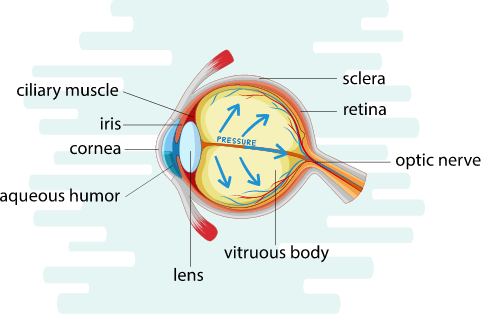About glaucoma
Glaucoma
What is glaucoma?
Glaucoma is an eye disease that damages the optic nerve which carries images from the eye to the brain. If not detected or treated, glaucoma can lead to permanent vision loss and blindness. Fortunately, with early detection and treatment, serious vision loss can be avoided in most cases.
Glaucoma is commonly associated with a buildup of pressure inside the eye. Normally, fluid circulates in the front part of the eye before draining out through a mesh-like channel. In glaucoma, this channel becomes blocked resulting in a build up of fluid pressure that can damage the optic nerve.

TYPES
Types of Glaucoma
Glaucoma is actually a group of diseases. The most common types of glaucoma are:
Open angle glaucoma
This is the most common form of glaucoma. In open angle glaucoma the mesh-like channel appears open but does not drain fluid efficiently. This results in a build up of pressure inside the eye which can damage the optic nerve. This type typically develops very slowly.
Angle closure glaucoma
This is more common in Asian populations. In angle closure glaucoma the coloured part of the eye (called the iris) blocks the mesh-like channel. Pressure usually rises slowly but can rise suddenly in this type of glaucoma.
Normal tension glaucoma
In this form of glaucoma, damage occurs to the optic nerve without high eye pressure.
Secondary glaucoma
This refers to glaucoma caused by trauma, surgery, inflammation, or certain medications.
Congenital glaucoma
This is a rare form of glaucoma that is present at birth or develops early in life. Here the drainage channels are not properly developed.

SYMPTOMS
Symptoms of glaucoma
Glaucoma typically has few or no symptoms until late in the disease. Initially, peripheral or side vision is lost, however this may go unnoticed. If left untreated, glaucoma can lead to loss of central vision and blindness. There is typically no pain or discomfort.
In some forms of glaucoma, eye pressure may rise suddenly causing eye pain, headache, blurred vision, and sometimes halos around lights.
Risk
Who is at risk?
Anyone can develop glaucoma. However, some people have an increased risk of developing glaucoma. The following factors increase the chance of developing glaucoma:
- A family history of glaucoma
- Age over 60 years
- African ancestry
- Being short sighted
- Having diabetes
- Using steroid medication for prolonged periods of time


diagnosis
How is glaucoma diagnosed?
Because glaucoma has few early symptoms or warning signs, it is important to see an optometrist or ophthalmologist for an eye examination. A glaucoma check will include:
- A measurement of your eye pressure
- A test of your side or peripheral vision
- Examination of the drainage channel of the eye with a special lens
- Examination of the optic nerve with a special lens, photograph, or imaging device


